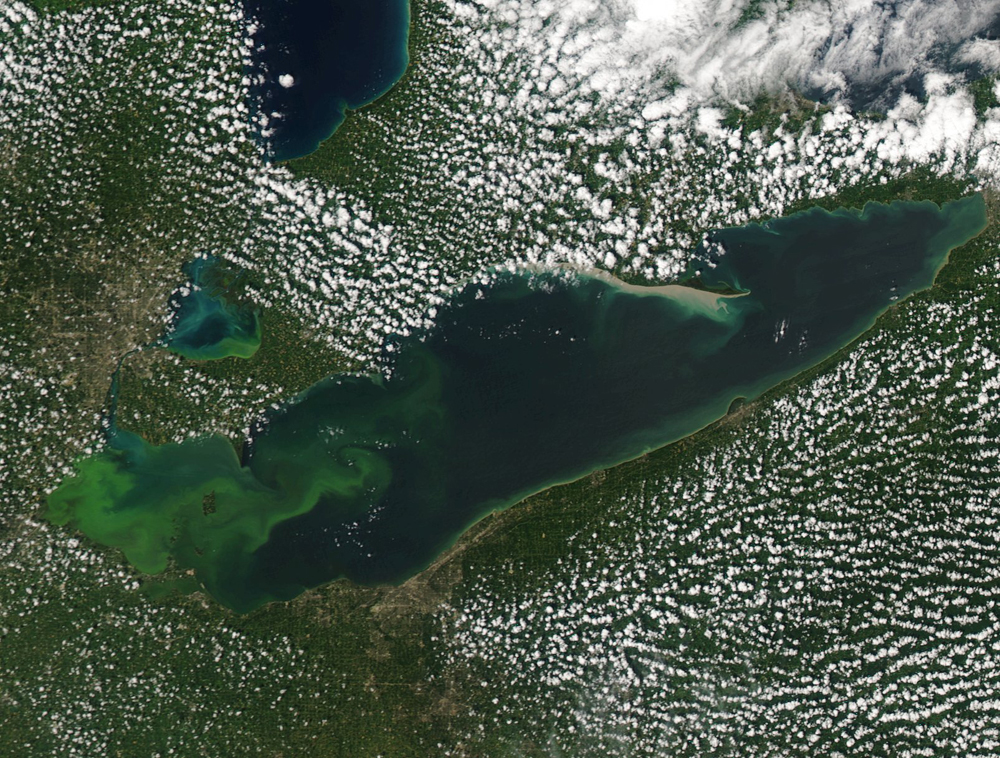
Turning the “Rust Belt” into the “Water Belt”
The Great Lakes are a national treasure. They contain 20% of the earth’s fresh surface water and are the drinking water source for more than 40 million people. However, dangerously outdated infrastructure remains a huge threat to our lakes. From combined sewer overflows to old lead service lines, our water infrastructure needs to be updated to protect water resources for future generations.
Failing wastewater infrastructure continues to release sewage and polluted storm water into local waterways every year, contaminating Great Lakes beaches, threatening public health and damaging local economies. Similarly, aging drinking water infrastructure is a costly challenge for many communities, as illustrated by threats to drinking water in Toledo, Ohio, from toxic algae in Lake Erie, and in Flint, Michigan, from lead contamination from improper water treatment and aging pipes. Water and wastewater infrastructure challenges are exacerbated by climate change impacts, such as increased runoff caused by more severe and frequent storm events that lead to increased flooding, sanitary and storm sewer overflows, and risks to public health and the health of the Great Lakes.
We need to act now and invest in updating and replacing our crumbling water infrastructure. According the U.S. Environmental Protection Agency (EPA), over the next 20 years almost $180 billion is needed to repair and upgrade our drinking water and wastewater infrastructure in the Great Lakes region. In Minnesota alone, the figure tops $11 billion. Nationally, the cost is even higher.
The pipes, structures, and buildings that make up our water infrastructure system are aging and rusting away. In the Great Lakes region, and around the country, funds for water infrastructure investments are inadequate to keep up with needs. Currently, the federal government helps communities pay for expensive, but urgently needed water infrastructure projects using the Clean Water or Drinking Water State Revolving Funds. These funds provide low-interest loans for qualifying community projects, but for some cash strapped communities even low-interest loans are unaffordable. Significant and continued funding for water infrastructure modernization is the only way to make sure we can reach our clean water goals
Every year the U.S. Congress debates and passes a budget for the nation, which contains funding for programs to address this crisis. But often that funding doesn’t match the size of the problem. Our U.S. Senators and Representatives need to consider several kinds of water infrastructure funding when they consider what programs to fund each year.
Unfortunately, some members of Congress and the President have tried to cut budgets for infrastructure and Great Lakes programs. The simple reason that our infrastructure is deteriorating in the Great Lakes region and across the country is that communities are having a hard time paying for expensive repairs and the federal government is only making the problem worse by not prioritizing water infrastructure. In 1977, federal funding made up 63% of all water infrastructure investments. By 2014, the federal government share had dropped to a mere 9% of funding. Local communities that are cash strapped are taking on a majority of the investment and consumers’ water rates have soared as a result. From 2010 to 2017, water rates have increased 41% across the country. Federal programs that provide low interest loans or grants to communities have a proven track record and we need to start making that investment again. The major programs at the federal level that need full or increased funding for protecting our water are:
- Clean Water State Revolving Fund
- Drinking Water State Revolving Fund
- Assistance for Small and Disadvantaged Communities grants
- Reducing Lead in Drinking Water grants
- Lead Testing in School and Child Care Program Drinking Water Grants
Many Senators in the Great Lakes region signed on to show their support for this important water infrastructure funding including Senator Klobuchar and Senator Smith here in Minnesota. Clean Water Action supports legislation in Congress that would provide grants to communities–not just loans–to address costly wastewater and drinking water infrastructure projects.
Clean Water Action looks forward to working with new leaders in Congress to pass an infrastructure funding plan that helps local communities meet their clean water goals, while making water affordable for everyone. This can include providing more grants to struggling communities, as opposed to loans, as well as helping utilities implement water affordability programs that help people pay their water bills so that they are never in danger of having their water shut off. Finally, we need a bi-partisan infrastructure package that works for people, communities, businesses, and the Great Lakes.
Who wants to be the rust belt? Just the image alone is one of deteriorating cities and communities. We want to be the “Water Belt”! Rightfully so, when we have more than 20% of the earth’s fresh surface water in our backyard. Clean Water staff will be watching as more details become available on these important programs, as affordability of water is one of the most important factors to being able to make long term infrastructure investments. We should be able to provide safe and affordable water to everyone in this great country. If we begin to prioritize our water infrastructure again and pressure Congress to invest in the Great Lakes region we can get rid of that image of being rusty, deteriorating, and old. So long “Rust Belt” and hello “Water Belt”!
If you have any questions or want to get more involved in protecting our Great Lakes from the problems caused by aging and deteriorating water infrastructure, please don’t hesitate to contact our Water Program Coordinator, Steve Schultz, sschultz[at]cleanwater[dot]org.
